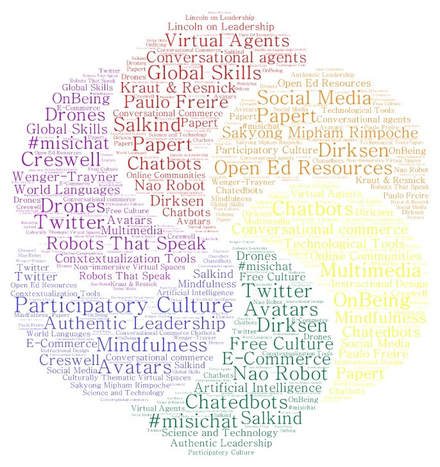Educational Technology Leadership Philosophy
I am a relationship builder. I instinctively serve as the link that brings people together, both professionally and personally. Because I always look for the best in others I am able to build relationships based on respect and appreciation. This ability allows me to establish connections with individuals of diverse backgrounds and tap on their skills to produce outcomes that I could not generate on my own. As a leader my strengths are anchored in responsibility, connectedness, relationship building, strategizing and learning (Rath & Conchie, 2008). Hence, I pursue all endeavors with commitment, by building meaningful relationships through empathy, learning from others, and strategizing a plan of action that is in the best interest of those involved.
The aforementioned qualities enable me to employ an Authentic Leadership style, parting from the premise that “everyone can develop authenticity and learn to be more authentic” (Northouse, p.268). It is my standpoint that just like students respect a teacher for being authentic, team members will respect a leader that is genuine. The Holden Leadership Center highlights the characteristics of authentic leaders according to Robin Sharma’s book ‘The Saint, the Surfer and the CEO.’ It proclaims that authentic leaders: speak their truth, lead from their heart, have a rich moral fiber, are courageous, build teams and create communities, deepen themselves, are dreamers, care for themselves, commit to excellence rather than perfection, and leave a legacy (University of Oregon, 2009). These are the objectives that I aim to achieve in leadership situations.
Notably, my educational technology philosophy is intertwined with a spiritual perspective on the use of technology as a means of contextualizing our existence (Fields, 2013). This viewpoint provides a clear framework for my professional practice and research, particularly in world language instruction. As an educator it is my intention to promote the integration of technological tools as a system that mirrors real-life purposes, with a lens into the products, practices and perspectives of people in local and global societies, for the deepening of the learning process.
I am a relationship builder. I instinctively serve as the link that brings people together, both professionally and personally. Because I always look for the best in others I am able to build relationships based on respect and appreciation. This ability allows me to establish connections with individuals of diverse backgrounds and tap on their skills to produce outcomes that I could not generate on my own. As a leader my strengths are anchored in responsibility, connectedness, relationship building, strategizing and learning (Rath & Conchie, 2008). Hence, I pursue all endeavors with commitment, by building meaningful relationships through empathy, learning from others, and strategizing a plan of action that is in the best interest of those involved.
The aforementioned qualities enable me to employ an Authentic Leadership style, parting from the premise that “everyone can develop authenticity and learn to be more authentic” (Northouse, p.268). It is my standpoint that just like students respect a teacher for being authentic, team members will respect a leader that is genuine. The Holden Leadership Center highlights the characteristics of authentic leaders according to Robin Sharma’s book ‘The Saint, the Surfer and the CEO.’ It proclaims that authentic leaders: speak their truth, lead from their heart, have a rich moral fiber, are courageous, build teams and create communities, deepen themselves, are dreamers, care for themselves, commit to excellence rather than perfection, and leave a legacy (University of Oregon, 2009). These are the objectives that I aim to achieve in leadership situations.
Notably, my educational technology philosophy is intertwined with a spiritual perspective on the use of technology as a means of contextualizing our existence (Fields, 2013). This viewpoint provides a clear framework for my professional practice and research, particularly in world language instruction. As an educator it is my intention to promote the integration of technological tools as a system that mirrors real-life purposes, with a lens into the products, practices and perspectives of people in local and global societies, for the deepening of the learning process.
References
Fields, J. (Presenter). (2013, July 10). Sakyong Mipham Rinpoche: The shambala principle and the good life [Audio Podcast]. In J. Fields (Producer), Good life project. Retrieved from http://www.goodlifeproject.com/sakyong-mipham-rinpoche
Northouse, P.G. (2013). Leadership:Theory and practice. Los Angeles: SAGE.
Rath, T. & Cochie, B. (2009). Strenghts-based leadership: Great leaders, teams, and why people follow. Washington DC: Gallup Press.
University of Oregon. (2009). 10 Things authentic leaders do. [Web log post]. Retrieved from http://leadership.uoregon.edu/resources/exercises_tips/leadership_reflections/10_things_authentic_leaders_do
Northouse, P.G. (2013). Leadership:Theory and practice. Los Angeles: SAGE.
Rath, T. & Cochie, B. (2009). Strenghts-based leadership: Great leaders, teams, and why people follow. Washington DC: Gallup Press.
University of Oregon. (2009). 10 Things authentic leaders do. [Web log post]. Retrieved from http://leadership.uoregon.edu/resources/exercises_tips/leadership_reflections/10_things_authentic_leaders_do

